Journal Description
Oxygen
Oxygen
is an international, peer-reviewed, open access journal on the whole field of oxygen research published quarterly online by MDPI.
- Open Access free for readers, with article processing charges (APC) paid by authors or their institutions.
- Rapid Publication: manuscripts are peer-reviewed and a first decision is provided to authors approximately 22.7 days after submission; acceptance to publication is undertaken in 7.2 days (median values for papers published in this journal in the second half of 2023).
- Recognition of Reviewers: APC discount vouchers, optional signed peer review, and reviewer names published annually in the journal.
- Oxygen is a companion journal of Antioxidants.
Latest Articles
Energy Metabolism as a Therapeutic Target in Cancer: The Role of Coenzyme Q10
Oxygen 2024, 4(2), 122-138; https://doi.org/10.3390/oxygen4020008 - 11 Apr 2024
Abstract
►
Show Figures
The generation of energy within cells is a fundamental process enabling cell survival, and as such it represents a potential target in cancer therapy. In this article, we therefore review the relative contributions of glycolysis and oxidative phosphorylation/mitochondrial function to cancer cell energy
[...] Read more.
The generation of energy within cells is a fundamental process enabling cell survival, and as such it represents a potential target in cancer therapy. In this article, we therefore review the relative contributions of glycolysis and oxidative phosphorylation/mitochondrial function to cancer cell energy generation, and we highlight their respective potential value as chemotherapeutic targets. This article is particularly focussed on the potential role of coenzyme Q10 in the prevention and treatment of cancer.
Full article
Open AccessEditorial
Oxygen: Highlights from the Papers Published in the Journal up to February 2024
by
John T. Hancock
Oxygen 2024, 4(1), 117-121; https://doi.org/10.3390/oxygen4010007 - 14 Mar 2024
Abstract
Oxygen (O2) was discovered approximately 250 years ago (Contribution 1), a breakthrough accredited to at least three people: Antoine-Laurent de Lavoisier in France (Antoine Lavoisier), Carl Wilhelm Scheele in Sweden, and Joseph Priestley in England [...]
Full article
Open AccessArticle
Expansion of Electron Transport Chain Mutants That Cause Anesthetic-Induced Toxicity in Drosophila melanogaster
by
Luke A. Borchardt, Zachariah P. G. Olufs, Philip G. Morgan, David A. Wassarman and Misha Perouansky
Oxygen 2024, 4(1), 108-116; https://doi.org/10.3390/oxygen4010006 - 02 Mar 2024
Abstract
The mitochondrial electron transport chain (mETC) contains molecular targets of volatile general anesthetics (VGAs), which places individuals with mETC mutations at risk for anesthetic complications, as exemplified by patients with Leigh syndrome (LS). The Drosophila melanogaster homozygous mutant for ND-23, which encodes
[...] Read more.
The mitochondrial electron transport chain (mETC) contains molecular targets of volatile general anesthetics (VGAs), which places individuals with mETC mutations at risk for anesthetic complications, as exemplified by patients with Leigh syndrome (LS). The Drosophila melanogaster homozygous mutant for ND-23, which encodes a subunit of mETC Complex I, replicates numerous characteristics of LS, including neurodegeneration, shortened lifespan, behavioral anesthetic hypersensitivity, and toxicity. The anesthetic phenotype of toxicity (lethality) is also observed in flies homozygous for mutations in other Complex I subunits. By contrast, mutations conferring sensitivity have not yet been identified for subunits of Complexes II–V. Furthermore, anesthetic phenotypes are thought to be recessive; that is, risk is not conferred by heterozygous mutations. However, at older ages, exposure of heterozygous mutant ND-23 flies to the VGA isoflurane in 75% oxygen (hyperoxia) results in toxicity. It is also unknown whether combinations of heterozygous mutations in different subunits of the mETC can result in anesthetic toxicity. Here, we show that, following exposure to isoflurane in hyperoxia, flies carrying heterozygous mutations in two Complex I subunits, ND-23 and ND-SGDH (NADH dehydrogenase (ubiquinone) SGDH subunit), had a level of anesthetic toxicity that exceeded the added toxicities of the individual heterozygous mutations. In addition, we show that flies heterozygous for two different alleles of the Complex II gene SdhB were susceptible to isoflurane/hyperoxia-induced anesthetic toxicity. Finally, a mutation in the SdhC subunit of Complex II of Caenorhabditis elegans resulted in isoflurane-induced mortality, supporting the role of Complex II in anesthetic toxicity. These data expand the landscape of mutations in the mETC that increase sensitivity to anesthetic toxicity.
Full article
(This article belongs to the Special Issue Mitochondrial Oxidative Stress in Health and Disease)
►▼
Show Figures

Figure 1
Open AccessArticle
Extraction of Bioactive Compounds from Cistus creticus Leaves and Their Use in the Preparation of Yogurt Desserts
by
Dimitrios Palaiogiannis, Vassilis Athanasiadis, Theodoros Chatzimitakos, Martha Mantiniotou, Eleni Bozinou, Dimitris P. Makris and Stavros I. Lalas
Oxygen 2024, 4(1), 90-107; https://doi.org/10.3390/oxygen4010005 - 12 Feb 2024
Abstract
The objective of this study was to determine the optimal conditions for the recovery of bioactive and antioxidant compounds in aqueous solutions of Cistus creticus leaves and then employ the optimal extract for the enrichment of yogurt samples. The optimal conditions were established
[...] Read more.
The objective of this study was to determine the optimal conditions for the recovery of bioactive and antioxidant compounds in aqueous solutions of Cistus creticus leaves and then employ the optimal extract for the enrichment of yogurt samples. The optimal conditions were established by a response surface methodology and were determined to be a liquid-to-solid ratio of 48 mL/g at 76 °C for 41 min. The optimum extract yielded TPC 157.17 mg GAE/g dw and TFC 2.38 mg QE/g dw, while FRAP and DPPH values were 1258.52 and 933.67 μmol AAE/g dw, respectively. HPLC-DAD was utilized to identify and quantify specific polyphenols, like myricetin rhamnoside, in the extract. The optimal extract was then added to yogurt desserts during their preparation at three different concentrations to study how the physicochemical characteristics of the yogurt, as well as the antioxidant capacity added during enrichment, were affected. Statistical analysis of the results was carried out in order to obtain more valid data. It seems that the most suitable concentration for yogurt fortification was 0.1% w/v of the extract as, at this concentration, the yogurts exhibited higher antioxidant capacity, and their physicochemical characteristics were improved.
Full article
(This article belongs to the Special Issue Feature Papers in Oxygen Volume Ⅱ)
►▼
Show Figures

Figure 1
Open AccessReview
The Thirty-Fifth Anniversary of K+ Channels in O2 Sensing: What We Know and What We Don’t Know
by
Asuncion Rocher and Philip I. Aaronson
Oxygen 2024, 4(1), 53-89; https://doi.org/10.3390/oxygen4010004 - 09 Feb 2024
Abstract
On the thirty-fifth anniversary of the first description of O2-sensitive K+ channels in the carotid body chemoreceptors O2 sensing remains a salient issue in the literature. Whereas much has been learned about this subject, important questions such as the
[...] Read more.
On the thirty-fifth anniversary of the first description of O2-sensitive K+ channels in the carotid body chemoreceptors O2 sensing remains a salient issue in the literature. Whereas much has been learned about this subject, important questions such as the identity of the specific K+ channel subtype(s) responsible for O2 sensing by chemoreceptors and the mechanism(s) by which their activities are altered by hypoxia have not yet been definitively answered. O2 sensing is a fundamental biological process necessary for the acute and chronic responses to varying environmental O2 levels which allow organisms to adapt to hypoxia. Whereas chronic responses depend on the modulation of hypoxia-inducible transcription factors which determine the expression of numerous genes encoding enzymes, transporters and growth factors, acute responses rely mainly on the dynamic modulation of ion channels by hypoxia, causing adaptive changes in cell excitability, contractility and secretory activity in specialized tissues. The most widely studied oxygen-sensitive ion channels are potassium channels, but oxygen sensing by members of both the calcium and sodium channel families has also been demonstrated. Given the explosion of information on this topic, in this review, we will focus on the mechanisms of physiological oxygen chemotransduction by PO2-dependent K+ channels, with particular emphasis on their function in carotid body chemoreceptor cells (CBCC) and pulmonary artery smooth muscle cells (PASMC), highlighting areas of consensus and controversy within the field. We will first describe the most well-established concepts, those reproduced in multiple laboratories, and then discuss selected observations or questions that remain unresolved, and that limit our progress in this field.
Full article
(This article belongs to the Special Issue Feature Papers in Oxygen Volume Ⅱ)
►▼
Show Figures
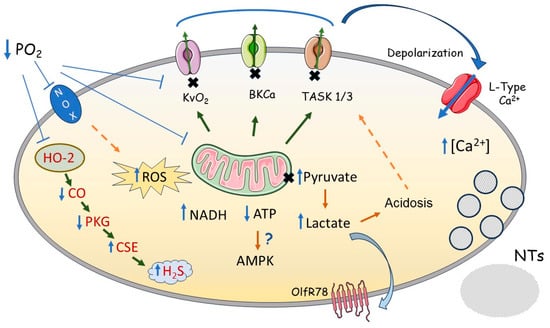
Figure 1
Open AccessPerspective
An Interplay of Gases: Oxygen and Hydrogen in Biological Systems
by
Grace Russell, Jennifer May and John T. Hancock
Oxygen 2024, 4(1), 37-52; https://doi.org/10.3390/oxygen4010003 - 09 Feb 2024
Abstract
Produced by photosynthesis, oxygen (O2) is a fundamentally important gas in biological systems, playing roles as a terminal electron receptor in respiration and in host defence through the creation of reactive oxygen species (ROS). Hydrogen (H2) plays a role
[...] Read more.
Produced by photosynthesis, oxygen (O2) is a fundamentally important gas in biological systems, playing roles as a terminal electron receptor in respiration and in host defence through the creation of reactive oxygen species (ROS). Hydrogen (H2) plays a role in metabolism for some organisms, such as at thermal vents and in the gut environment, but has a role in controlling growth and development, and in disease states, both in plants and animals. It has been suggested as a medical therapy and for enhancing agriculture. However, the exact mode of action of H2 in biological systems is not fully established. Furthermore, there is an interrelationship between O2 and H2 in organisms. These gases may influence each other’s presence in solution, and may both interact with the same cellular components, such as haem prosthetic groups. It has also been suggested that H2 may affect the structures of some proteins, such as globins, with possible effects on O2 movement in organisms. Lastly, therapies may be based on supplying O2 and H2 together, such as with oxyhydrogen. Therefore, the relationship regarding how biological systems perceive and respond to both O2 and H2, and the interrelationship seen are worth considering, and will be discussed here.
Full article
(This article belongs to the Special Issue Interaction of Oxygen and Other Gases with Haem Containing Proteins)
►▼
Show Figures

Figure 1
Open AccessSystematic Review
Pre-Clinical Studies of MicroRNA-Based Therapies for Sepsis: A Scoping Review
by
Amin M. Ektesabi, Julia Simone, Chirag Vaswani, Greaton W. Tan, Yanbo Wang, Jacqueline L. Pavelick, Xiao Wu, Janice Tai, Sahil Gupta, James N. Tsoporis and Claudia C. dos Santos
Oxygen 2024, 4(1), 20-36; https://doi.org/10.3390/oxygen4010002 - 29 Jan 2024
Abstract
►▼
Show Figures
Background: Sepsis is a severe and life-threatening condition triggered by a dysregulated response to infection, leading to organ failure and, often, death. The syndrome is expensive to treat, with survivors frequently experiencing reduced quality of life and enduring various long-term disabilities. The increasing
[...] Read more.
Background: Sepsis is a severe and life-threatening condition triggered by a dysregulated response to infection, leading to organ failure and, often, death. The syndrome is expensive to treat, with survivors frequently experiencing reduced quality of life and enduring various long-term disabilities. The increasing understanding of RNA, RNA biology, and therapeutic potential offers an unprecedented opportunity to develop innovative therapy. Objective: This study is a scoping review focusing on pre-clinical studies of microRNA (miRNA)-based therapies for sepsis. Methodology: A scoping review. The search strategy identified papers published in PubMed until 15 October 2023, using the keywords (microRNA) AND (sepsis) AND (animal model). Inclusion criteria included papers that used either gain- or loss-of-function approaches, excluding papers that did not focus on microRNAs as therapy targets, did not include animal models, did not show organ failure-specific assessments, and focused on microRNAs as biomarkers. The PRISMA-ScR guideline was used in this study. Results: A total of 199 articles were identified that featured the terms “microRNA/miRNA/miR”, “Sepsis”, and “animal model”. Of these, 51 articles (25.6%) employed miRNA-based therapeutic interventions in animal models of sepsis. Of these, 15 studies extended their inquiry to include or reference human clinical data. Key microRNAs of interest and their putative mechanisms of action in sepsis are highlighted. Conclusions: The body of work examined herein predominantly addresses various dimensions of sepsis-induced organ dysfunction, supporting the emerging role of miRNAs as potential therapeutic candidates. However, nearly 5% of papers on miR-based therapy have been retracted over the past 5 years, raising important concerns regarding the quality and complexity of the biology and models for assessing therapeutic potential.
Full article

Figure 1
Open AccessArticle
Antioxidant-Rich Extracts from Lemon Verbena (Aloysia citrodora L.) Leaves through Response Surface Methodology
by
Vassilis Athanasiadis, Theodoros Chatzimitakos, Ioannis Makrygiannis, Dimitrios Kalompatsios, Eleni Bozinou and Stavros I. Lalas
Oxygen 2024, 4(1), 1-19; https://doi.org/10.3390/oxygen4010001 - 22 Jan 2024
Cited by 1
Abstract
►▼
Show Figures
A member of the Verbenaceae family, Aloysia citrodora, or lemon verbena, is a medicinal herb with antioxidant compounds. The aim of this study was to develop a green, optimized method for the bioactive compound (carotenoids, ascorbic acid, and polyphenols) extraction from lemon
[...] Read more.
A member of the Verbenaceae family, Aloysia citrodora, or lemon verbena, is a medicinal herb with antioxidant compounds. The aim of this study was to develop a green, optimized method for the bioactive compound (carotenoids, ascorbic acid, and polyphenols) extraction from lemon verbena leaves through response surface methodology (RSM). The bioactive compound recovery was shown to be significantly affected by the extraction technique (both with pulsed electric field and ultrasound-assisted extraction), along with an extraction solvent, based on partial least squares analysis. Consequently, the maximum polyphenol yield required a double-assisted extraction with a relatively low extraction duration (60 min) at a high temperature (80 °C), with a moderate-polarity extraction solvent (50% v/v ethanol). With the optimized method, the total polyphenol content (TPC) was measured at 175.03 mg gallic acid equivalents/g, whereas chromatographic analysis revealed that verbascoside was the most prevalent polyphenol (132.61 mg/g). The optimum extract provided a high antioxidant capacity through the measurements of FRAP (1462.17 μmol ascorbic acid equivalents (AAE)/g), DPPH (1108.91 μmol AAE/g), and H2O2 (1662.93 μmol AAE/g). Total carotenoids were measured at 499.61 μg/g, with ascorbic acid at 8.36 μg/g. Correlation analyses revealed a negative correlation of the latter compound with color coordinates. This study highlights the potential of lemon verbena leaves to be used in pharmaceutical and food industries.
Full article

Figure 1
Open AccessReview
Molecular Mechanisms of Oxygen Evolution Reactions for Artificial Photosynthesis
by
Yoshio Nosaka
Oxygen 2023, 3(4), 407-451; https://doi.org/10.3390/oxygen3040027 - 16 Nov 2023
Abstract
►▼
Show Figures
Addressing the global environmental problem of water splitting to produce hydrogen fuel by solar energy is receiving so much attention. In water splitting, the essential problem to solve is the development of efficient catalysts for oxygen production. In this paper, having the prospect
[...] Read more.
Addressing the global environmental problem of water splitting to produce hydrogen fuel by solar energy is receiving so much attention. In water splitting, the essential problem to solve is the development of efficient catalysts for oxygen production. In this paper, having the prospect for a practical application of photocatalysts to artificial photosynthesis, molecular mechanisms in the current literature are briefly reviewed. At first, recent progress in the function of the Mn cluster at the natural photosystem II is briefly described. The kinds of devices in which oxygen evolution reaction (OER) catalysts are used were designated: water electrolyzers, photoelectrodes, and photocatalysts. Some methods for analyzing molecular mechanisms in OER catalysis, emphasized by the FTIR method, are shown briefly. After describing common OER mechanisms, the molecular mechanisms are discussed for TiO2 and BiVO4 photoelectrodes with our novel data, followed by presenting OER co-catalysts of IrO2, RuO2, NiO2, and other metal oxides. Recent reports describing OER catalysts of perovskites, layered double hydroxides (LDH), metal–organic frameworks (MOF), single-atom catalysts, as well as metal complexes are reviewed. Finally, by comparing with natural photosystem, the required factors to improve the activity of the catalysts for artificial photosynthesis will be discussed.
Full article

Figure 1
Open AccessReview
Mitochondrial Dysfunction and Nanocarrier-Based Treatments in Chronic Obstructive Pulmonary Disease (COPD)
by
Kiyoshi Sato and Hiroyoshi Kawakami
Oxygen 2023, 3(4), 394-406; https://doi.org/10.3390/oxygen3040026 - 14 Nov 2023
Cited by 1
Abstract
Mitochondrial dysfunction significantly contributes to the pathogenesis and progression of chronic obstructive pulmonary disease (COPD). To treat mitochondrial dysfunction in COPD, novel drug delivery systems (DDS) are needed. In this review, we provide a brief overview of the current understanding of the factors
[...] Read more.
Mitochondrial dysfunction significantly contributes to the pathogenesis and progression of chronic obstructive pulmonary disease (COPD). To treat mitochondrial dysfunction in COPD, novel drug delivery systems (DDS) are needed. In this review, we provide a brief overview of the current understanding of the factors in COPD and highlight the trends in novel nanocarriers/nanoparticles for targeting mitochondrial dysfunction. These drug-encapsulated nanoparticles are still in the early stages of clinical application but represent the most promising system for COPD therapy.
Full article
(This article belongs to the Special Issue Mitochondrial Oxidative Stress in Health and Disease)
►▼
Show Figures

Figure 1
Open AccessArticle
The Influence of the Atmospheric Electric Field on Soil Redox Potential
by
Konstantinos Kourtidis and Michel Vorenhout
Oxygen 2023, 3(4), 386-393; https://doi.org/10.3390/oxygen3040025 - 19 Oct 2023
Abstract
►▼
Show Figures
Atmospheric electric fields (AEFs) have recently been proposed to link to biogeochemical processes below the Earth’s surface by means of a charge separation. Despite the potential importance of such a process, up to now we almost completely lack the relevant measurements. Here, we
[...] Read more.
Atmospheric electric fields (AEFs) have recently been proposed to link to biogeochemical processes below the Earth’s surface by means of a charge separation. Despite the potential importance of such a process, up to now we almost completely lack the relevant measurements. Here, we extend the database with 2 months of concurrent soil redox and atmospheric electric field measurements. It appears that the changes that occur in the order of days in soil redox are at periods anticorrelated with the logarithm of the positive values of the AEF. However, weather conditions might be driving the anticorrelation rather than a direct link, as the synoptic weather conditions appear to influence soil redox. Soil redox does not respond to changes in the AEF that are of shorter duration, either minutes or several hours, except in some cases of very negative AEFs or very high field strengths in the presence of moderate rainfall. In such a case, the variation in soil redox could be associated with a mechanism that transfers charge to the ground or brings ions towards the ground’s surface. To reach firmer conclusions on the effect of the AEF on soil redox, we need to extend the range of collocated soil redox and AEF measurements so that they cover at least one year.
Full article

Figure 1
Open AccessArticle
The Kelch/Nrf2 Antioxidant System as a Target for Some Marine Fungal Metabolites
by
Ekaterina A. Yurchenko, Olga O. Khmel, Liliana E. Nesterenko and Dmitry L. Aminin
Oxygen 2023, 3(4), 374-385; https://doi.org/10.3390/oxygen3040024 - 28 Sep 2023
Abstract
►▼
Show Figures
Marine fungal metabolites often exhibit antioxidant activity, but their effects on the Keap1/Nrf2 cellular system are rarely studied, possibly due to insufficient isolated amounts. In this work, we used a bioinformatics approach to evaluate the ability of some promising cytoprotective compounds to bind
[...] Read more.
Marine fungal metabolites often exhibit antioxidant activity, but their effects on the Keap1/Nrf2 cellular system are rarely studied, possibly due to insufficient isolated amounts. In this work, we used a bioinformatics approach to evaluate the ability of some promising cytoprotective compounds to bind Kelch domain of Keap1 protein, and thus inhibit its interaction with Nrf2. The molecular docking data suggested that gliorosein, niveoglaucin A, 6-hydroxy-N-acetyl-β-oxotryptamine, 4-hydroxyscytalone and 4-hydroxy-6-dehydroxyscytalone can form the hydrogen building with Arg415 or Arg483 amino acid residues of P1-P2 sub-pockets in the Nrf2 binding site of Keap1′s Kelch domain. These positions of the small molecules in the Kelch domain of Keap1 can inhibit the interaction of Keap1 with Nrf2 and enhance the nuclear translocation of Nrf2 from cytosol that can result in overexpression of relative genes. This assumption, based on virtual screening of a number of low molecular weight metabolites of marine fungi, makes them promising for further studies.
Full article
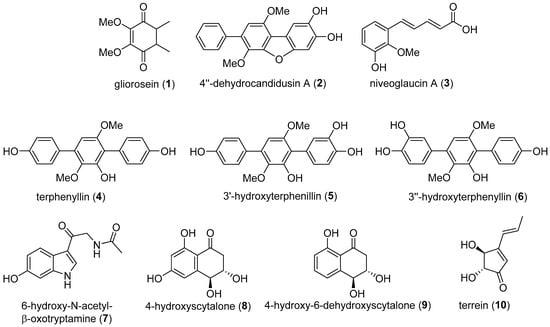
Figure 1
Open AccessBrief Report
Exploring the Impact of Training Methods on Repeated Sprints in Hypoxia Training Effects
by
Daniel Rojas-Valverde, Aldo A. Vasquez-Bonilla, Rafael Timón, Joan M. Feliu-Ilvonen, Ismael Martínez-Guardado and Guillermo Olcina
Oxygen 2023, 3(3), 366-373; https://doi.org/10.3390/oxygen3030023 - 08 Sep 2023
Abstract
Background: Emerging evidence suggests that the outcomes of hypoxia training may be influenced by various factors, contingent upon the chosen method, such as chamber, tent, or mask. This study aimed to examine how different training methods influence the effects of Repeated Sprints in
[...] Read more.
Background: Emerging evidence suggests that the outcomes of hypoxia training may be influenced by various factors, contingent upon the chosen method, such as chamber, tent, or mask. This study aimed to examine how different training methods influence the effects of Repeated Sprints in Hypoxia (RSH) training. Methods: Sixteen well-trained cyclists were divided into two groups, experimental (tent; n = 8) and control (mask; n = 8), and carried out eight RSH sessions for four weeks. Training sessions consisted of three bouts of high-intensity sprints using a cycle ergometer. The indoor ambient conditions (CO2, temperature, and humidity), performance variables (power and relative power output), arterial oxygen saturation, local muscle oxygen of vastus lateralis, heart rate, core temperature, and physiological variables (perception of effort) were measured in each training session. Results: The experimental group reported significantly higher CO2 (p < 0.001 ES = 0.784), humidity levels (p < 0.001 ES = 0.750), thermal discomfort (p = 0.003 ES = 0.266), dehydration (p 0.025 ES = 0.097), heart rate (p = 0.017 ES = 0.113), and lower muscle oxygen amplification (p = 0.002 ES = 0.181) than the control group. Conclusion: According to the responses observed, interval training performed under hypoxic conditions inside a chamber induces a more severe physiological response.
Full article
Open AccessReview
The Ion Channels Involved in Oxidative Stress-Related Gastrointestinal Diseases
by
Maria Rosaria Miranda, Vincenzo Vestuto, Ornella Moltedo, Michele Manfra, Pietro Campiglia and Giacomo Pepe
Oxygen 2023, 3(3), 336-365; https://doi.org/10.3390/oxygen3030022 - 21 Aug 2023
Cited by 1
Abstract
The pathogenesis of various gastrointestinal (GI) disorders, including gastritis, ulcers, inflammatory bowel disease (IBD) and cancer, can be linked to oxidative stress. It is known that reactive species carry out a crucial role in the genesis and progression of these pathologies; however, the
[...] Read more.
The pathogenesis of various gastrointestinal (GI) disorders, including gastritis, ulcers, inflammatory bowel disease (IBD) and cancer, can be linked to oxidative stress. It is known that reactive species carry out a crucial role in the genesis and progression of these pathologies; however, the contribution of ionic channels in their development is still under discussion. The function of ion channels in the gastrointestinal tract influences a variety of cellular processes. Acid-base balance, mucus layer, microbiota and mucosal blood flow are only some of the essential features for maintaining the mucosal integrity of the cellular barrier in the intestine, allowing for the preservation of proper permeability and ensuring tissue homeostasis. As the functional modulation of several ion channels is altered during oxidative stress conditions associated with gastrointestinal inflammation, this review focuses on contributing new insight into the roles of and the relationship between ion channels and oxidative stress in GI diseases. The association between ion channels and oxidative stress conditions could be used in diagnostics and the development of new pharmacological treatments for major gastrointestinal diseases.
Full article
(This article belongs to the Special Issue Feature Papers in Oxygen Volume Ⅱ)
►▼
Show Figures
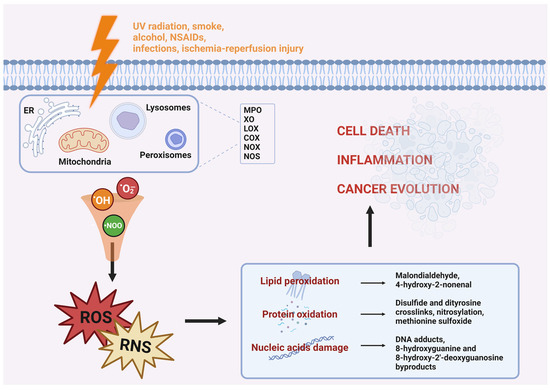
Figure 1
Open AccessReview
Photochemical and Photophysical Properties of Carotenoids and Reactive Oxygen Species: Contradictions Relating to Skin and Vision
by
Fritz Boehm, Ruth Edge and T. George Truscott
Oxygen 2023, 3(3), 322-335; https://doi.org/10.3390/oxygen3030021 - 03 Aug 2023
Abstract
►▼
Show Figures
Molecular mechanisms based on photo-physical processes involving dietary carotenoids, their radicals, and the role of oxygen are discussed and used to suggest explanations of the poorly understood and often contradictory results related to mainly skin and vision. Differing and conflicting efficiencies of singlet
[...] Read more.
Molecular mechanisms based on photo-physical processes involving dietary carotenoids, their radicals, and the role of oxygen are discussed and used to suggest explanations of the poorly understood and often contradictory results related to mainly skin and vision. Differing and conflicting efficiencies of singlet oxygen reactions with carotenoids of biological importance are discussed in environments from ‘simple’ organic solvents to single He La cells. A range of free radical reactions with carotenoids, and the corresponding radicals of the carotenoids themselves, are compared and used to explain the switch from beneficial to deleterious processes involving dietary carotenoids and to unravel their differing functions; of particular interest is a possible role for vitamin C.
Full article

Scheme 1
Open AccessReview
Hypoxia-Driven Responses in Chronic Kidney Disease
by
Verónica Miguel and Alba Rojo
Oxygen 2023, 3(3), 300-321; https://doi.org/10.3390/oxygen3030020 - 12 Jul 2023
Cited by 1
Abstract
►▼
Show Figures
Chronic kidney disease (CKD) affects 10% of the population. Fibrosis is the hallmark of CKD, which is marked by the deposit of extracellular matrix (ECM). This response is the final outcome of an unbalanced reaction to inflammation and wound healing and can be
[...] Read more.
Chronic kidney disease (CKD) affects 10% of the population. Fibrosis is the hallmark of CKD, which is marked by the deposit of extracellular matrix (ECM). This response is the final outcome of an unbalanced reaction to inflammation and wound healing and can be induced by a variety of insults, including hypoxia. Vascular damage results in an impaired tissue oxygen supply, inducing immune cell infiltration, tubule injury and the activation of ECM-secreting myofibroblasts. In turn, tubulointerstitial fibrosis development worsens oxygen diffusion. Hypoxia-inducible factor (HIF) is the primary transcriptional regulator of hypoxia-associated responses, such as oxidative stress and metabolic reprogramming, triggering a proinflammatory and profibrotic landscape. In this review, we discuss hypoxia-driven reprogramming in CKD as well as potential therapeutic approaches to target chronic hypoxia.
Full article
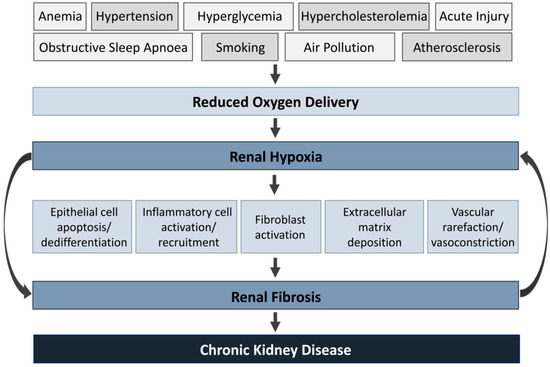
Figure 1
Open AccessPerspective
Oxygen in the Earth System
by
Klemens Hocke
Oxygen 2023, 3(3), 287-299; https://doi.org/10.3390/oxygen3030019 - 27 Jun 2023
Cited by 1
Abstract
Atmospheric oxygen is produced and consumed by life on Earth, and the ozone layer protects life on Earth from harmful solar UV radiation. The research on oxygen in the Earth system is of interest to many different geoscientific communities, from paleoclimatology to aeronomy.
[...] Read more.
Atmospheric oxygen is produced and consumed by life on Earth, and the ozone layer protects life on Earth from harmful solar UV radiation. The research on oxygen in the Earth system is of interest to many different geoscientific communities, from paleoclimatology to aeronomy. I provide a brief overview of the research activities and their motivations. In situ measurements and remote sensing of atmospheric oxygen are described. The global evolution, distribution, and trends of atmospheric oxygen are discussed.
Full article
(This article belongs to the Special Issue Feature Papers in Oxygen Volume Ⅱ)
►▼
Show Figures

Figure 1
Open AccessArticle
Successive Solvent Extraction of Polyphenols and Flavonoids from Cistus creticus L. Leaves
by
Dimitrios Palaiogiannis, Theodoros Chatzimitakos, Vassilis Athanasiadis, Eleni Bozinou, Dimitris P. Makris and Stavros I. Lalas
Oxygen 2023, 3(3), 274-286; https://doi.org/10.3390/oxygen3030018 - 23 Jun 2023
Cited by 3
Abstract
►▼
Show Figures
The aim of this study was to evaluate the efficiency of successive extraction (using solvents of increasing polarity, namely hexane, ethyl acetate, acetone, ethanol, and water) of polyphenols from Cistus creticus L. The results were compared with the ones obtained from a single-solvent
[...] Read more.
The aim of this study was to evaluate the efficiency of successive extraction (using solvents of increasing polarity, namely hexane, ethyl acetate, acetone, ethanol, and water) of polyphenols from Cistus creticus L. The results were compared with the ones obtained from a single-solvent extraction (ethanol, water, and 50% ethanol: water). According to the results, each solvent used for extraction had a significant effect on the yield of extracted polyphenols and the antioxidant activity of the extracts. The highest extraction yield for successive extraction was achieved with ethanol (95.33 mg GAE/g), whereas a comparable amount could also be extracted with 50% ethanol: water mixture single-solvent extraction (96.51 mg GAE/g). The ethanolic and aqueous extracts had the highest antioxidant activity as indicated by their lowest IC50 values in the DPPH assay, specifically 350.99 μg/mL for ethanolic extract of successive extraction and 341.18 μg/mL for 50% ethanol: water mixture of single-solvent extraction, followed by the extract produced using acetone. However, the acetone extract contained more flavonoids than the other two extracts up to 28.03 mg QE/g. The results obtained were in line with those for the single-solvent extraction. It is concluded that using a range of solvents in succession is a more efficient way of extracting higher amounts of antioxidant compounds with varying antioxidant activity.
Full article
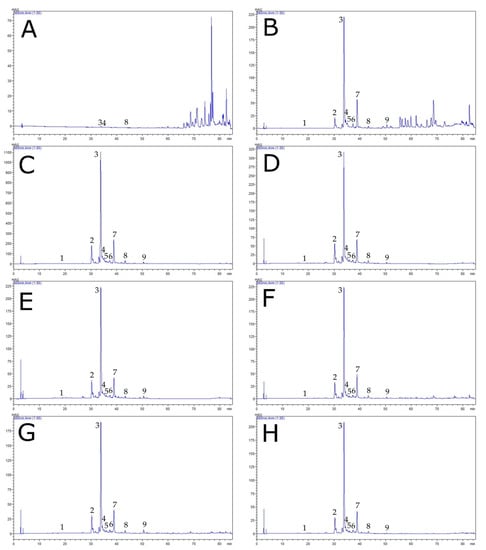
Figure 1
Open AccessArticle
Study of the Total Phenolic Content, Total Antioxidant Activity and In Vitro Digestibility of Novel Wheat Crackers Enriched with Cereal, Legume and Agricultural By-Product Flours
by
Despina Chatziharalambous, Chrysoula Kaloteraki, Panagiota Potsaki, Olga Papagianni, Konstantinos Giannoutsos, Danai I. Koukoumaki, Dimitris Sarris, Konstantinos Gkatzionis and Antonios E. Koutelidakis
Oxygen 2023, 3(2), 256-273; https://doi.org/10.3390/oxygen3020017 - 16 Jun 2023
Cited by 1
Abstract
Wheat-flour crackers represent a staple snack option, although they lack nutritional value. Agricultural by-products such as olive and grape seeds, cereals such as barley and legumes such as lupine and chickpea are rich in bioactive compounds; therefore, flours obtained from those could represent
[...] Read more.
Wheat-flour crackers represent a staple snack option, although they lack nutritional value. Agricultural by-products such as olive and grape seeds, cereals such as barley and legumes such as lupine and chickpea are rich in bioactive compounds; therefore, flours obtained from those could represent a better option for bakery products fortification. The purpose of the present study was the investigation of total phenolic content and antioxidant activity before and after the baking of wheat crackers enriched with 10–30% olive seed, 10–30% grape seed, 10–40% lupine, 10–30% barley and 20–60% and 80% chickpea flours and the evaluation of the predicted bioavailability after in vitro digestion of crackers demonstrating the highest values. Crackers and doughs were processed and analyzed using Folin–Ciocâlteu and ferric reducing antioxidant power (FRAP) assays, respectively. Crackers with the highest properties were subjected to in vitro gastrointestinal digestion. Baking resulted in an increase in total phenolics and antioxidant activity in the majority of crackers. Olive and grape seed flour crackers demonstrated the highest antioxidant properties. Following in vitro digestion, 30% olive seed flour crackers retained the majority of polyphenols and antioxidant activity. Crackers enriched with 30% olive seed flour could represent a healthy functional bakery snack regarding their increased antioxidant properties.
Full article
(This article belongs to the Special Issue Feature Papers in Oxygen Volume Ⅱ)
►▼
Show Figures

Figure 1
Open AccessReview
Flow Cytometry of Oxygen and Oxygen-Related Cellular Stress
by
Beatriz Jávega, Guadalupe Herrera, Alicia Martínez-Romero and José-Enrique O’Connor
Oxygen 2023, 3(2), 222-255; https://doi.org/10.3390/oxygen3020016 - 05 Jun 2023
Cited by 1
Abstract
►▼
Show Figures
Reactive oxygen species (ROS) are unstable and highly reactive molecular forms that play physiological roles in cell signaling and immune defense. However, when ROS generation is not properly balanced by antioxidant defenses, a pathological condition known as oxidative stress arises, in association with
[...] Read more.
Reactive oxygen species (ROS) are unstable and highly reactive molecular forms that play physiological roles in cell signaling and immune defense. However, when ROS generation is not properly balanced by antioxidant defenses, a pathological condition known as oxidative stress arises, in association with the onset and progression of many diseases and conditions, including degeneration and aging. Biomarkers of oxidative stress in biomedicine are actively investigated using different approaches, among which flow cytometry (FCM) and other single-cell, fluorescence-based techniques are most frequent. FCM is an analytical method that measures light scattering and emission of multiple fluorescences by single cells or microscopic particles at a very fast rate. To assess the specific role of ROS in oxidative stress, it is essential to detect and characterize these species accurately. However, the detection and quantitation of individual intracellular ROS and parameters of oxidative stress using fluorogenic substrates and fluorescent probes are still a challenge, because of biological and methodological issues. In this review, we present and discuss a series of complementary strategies to detect ROS or to focus on other endpoints of oxidative stress. Based on our results, we propose some recommendations for proper design of cytometric studies of oxidative stress in order to prevent or minimize the limitations and experimental errors of such approaches.
Full article
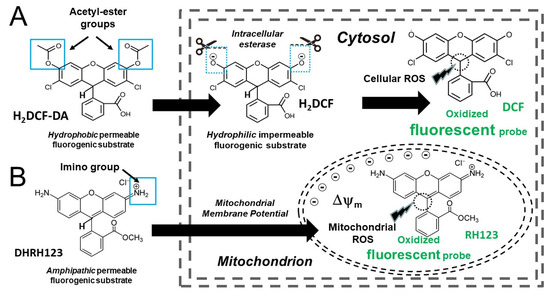
Figure 1
Highly Accessed Articles
Latest Books
E-Mail Alert
News
Topics
Topic in
Biomedicines, Cells, IJMS, Life, Oxygen
Oxidative Stress and Inflammation, 2nd Volume
Topic Editors: Mohamad Allaw, Ines Castangia, Maria Letizia Manca, Matteo Perra, Amparo NacherDeadline: 31 May 2024

Conferences
Special Issues
Special Issue in
Oxygen
Interaction of Oxygen and Other Gases with Haem Containing Proteins
Guest Editor: John T. HancockDeadline: 31 August 2024




